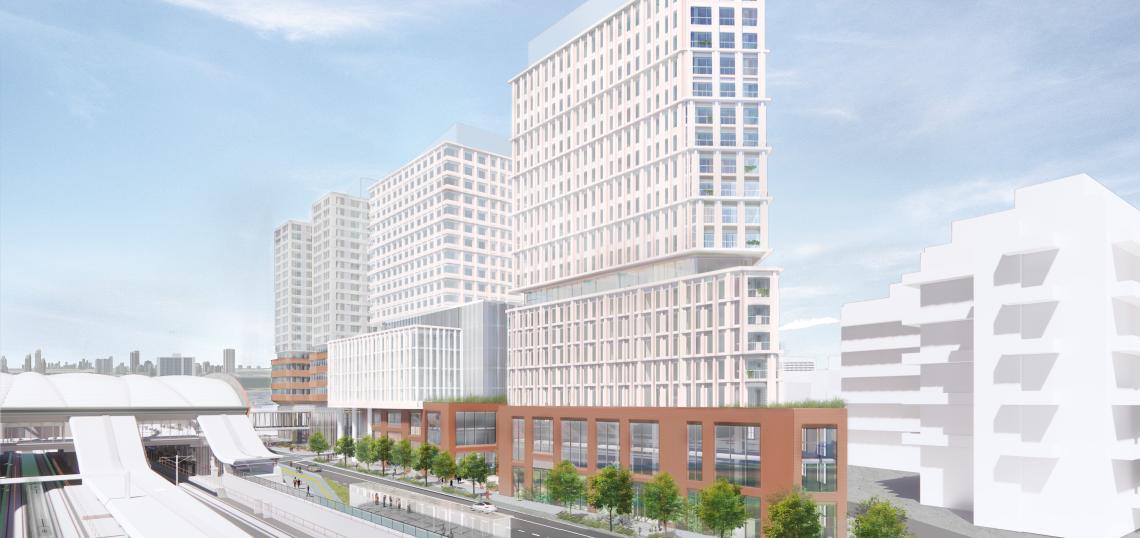Toronto and the GTA are in the midst of North America’s largest transit expansion.
With $80B invested across more than 40 different transit projects in 16 municipalities, new routes and stations will connect and reshape communities across the entire region.
Urbanize Toronto recently interviewed Shonda Wang, a Principal at SvN with over thirty years of experience in community development and large-scale urban regeneration projects. She specializes in developing connections between the public realm, the built environment, and urban infrastructure — most notably, transportation infrastructure. Her work has won several awards for urban design, and she has served as a trusted strategic advisor to prominent clients in both the private and public sector.
What are Transit-Oriented Communities (TOCs) and what are the greatest challenges with designing and planning them? Find out all the answers and more in our exclusive Q&A!
Q: Introduce yourself.
A: My name is Shonda Wang, and I'm the Principal at SvN, specializing in large-scale urban regeneration projects with a focus on mobility, planning, and design. With nearly two decades of experience, I've had the privilege of leading transformative transit-oriented intensification projects that aim to foster walkable and thriving communities.
My passion lies in crafting spaces that not only meet today's needs but also anticipate the demands of the future, ensuring sustainable and inclusive urban development. Over the course of my career, I've had the opportunity to spearhead several pivotal transportation and mobility initiatives, including the Dundas Connects Master Plan for the City of Mississauga, the Eglinton Avenue Planning, Urban Design and Built Form Study for the City of Toronto, and the Six Points Interchange Reconfiguration in Etobicoke. A key aspect of my work revolves around enhancing the synergy between the public realm, built form, and transportation infrastructure, particularly around Major Transit Station Areas.
 Shonda Wang is a Principal at SvN with over thirty years of experience in community development and large-scale urban regeneration projects. Image Credit: SvN
Shonda Wang is a Principal at SvN with over thirty years of experience in community development and large-scale urban regeneration projects. Image Credit: SvN
Recently, I served as Project Director on significant projects such as the Planning Advisor for New Subways for Infrastructure Ontario, the Danforth GO Connectivity Study and the Main Street Planning Study for the City of Toronto. I also led the Planning and Urban Design for the Shoppers World Brampton redevelopment for a 50-acre site at the terminus of the Hurontario LRT, that received unanimous Council approval with zero appeals.
Currently, I am the Lead Technical Advisor to Metrolinx and Infrastructure Ontario for Transit Oriented Communities along the Ontario Line, supporting engagement efforts with the City of Toronto to balance technical, market, and community requirements and Lead of Transit Oriented Communities for the development partner team, Scarborough Transit Connects, for the Scarborough Subway Extension.
Q: What are Transit Oriented Communities (TOCs)?
A: Transit-Oriented Community (TOC) is a planning and development approach that focuses on creating vibrant, livable communities centered around high-quality public transit systems. Typically featuring higher-density residential and commercial mixed-use development, TOC supports public transit viability and encourages a mix of housing, employment, and services within easy walking distance of transit stations. The idea is that the mix supports a vibrant community where people can live, work, shop, and play near each other and to transit services. By concentrating development around transit stations, TOCs can stimulate local economies, attract businesses, and create job opportunities, making communities more resilient and dynamic.
In our work with TOCs, SvN aims to create a high quality of life for residents by promoting a lifestyle that is less dependent on cars, thereby enhancing mobility, reducing traffic congestion, and improving air quality. By focusing development around transit, TOCs support more efficient use of land, create more cohesive neighbourhoods, and contribute to the overall sustainability of urban areas.
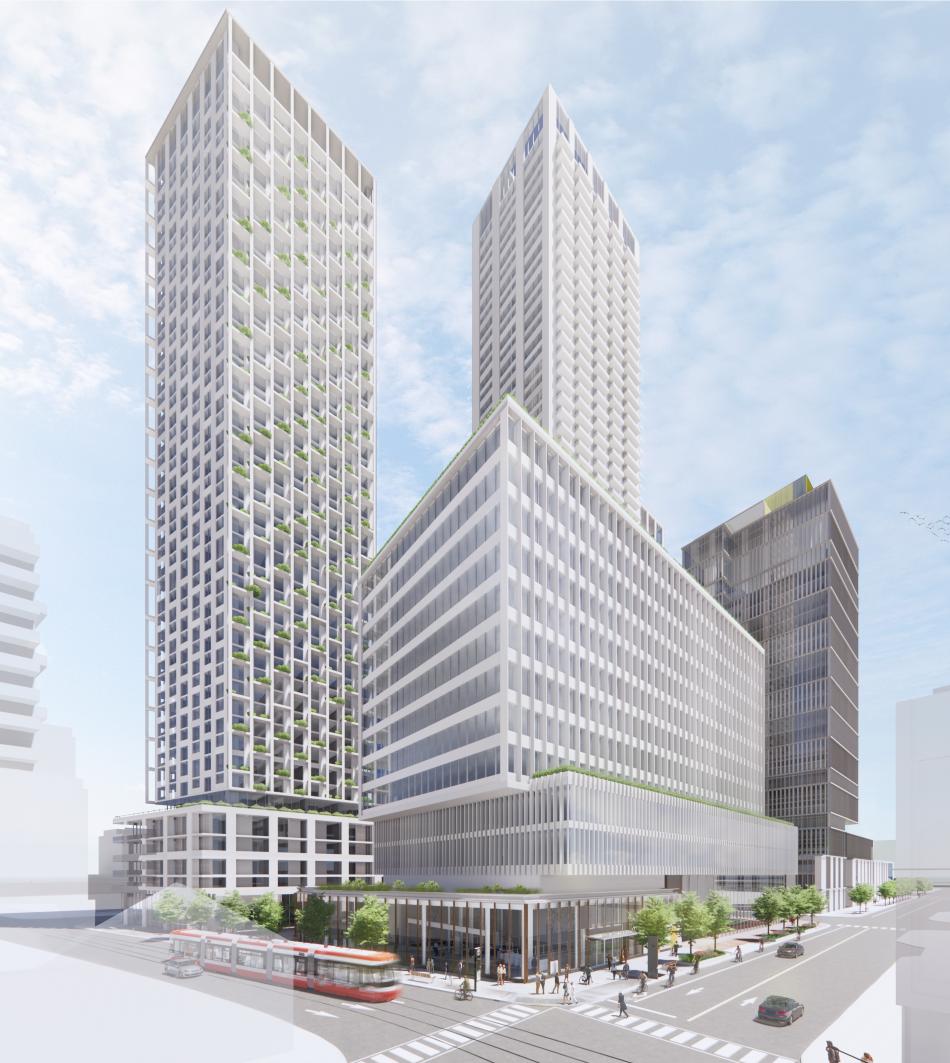 The Ontario Line’s Corktown Station is located at the southeast corner of King Street East and Berkeley Street in Toronto. Working with Metrolinx and Infrastructure Ontario, and as part of the Ontario Line Technical Advisor Team, SvN is proposing two sites to be developed through the Province of Ontario’s TOC program. The proposed TOC developments will deliver new transit-supportive housing, employment opportunities and community spaces within easy reach of transit. Image via SvN
The Ontario Line’s Corktown Station is located at the southeast corner of King Street East and Berkeley Street in Toronto. Working with Metrolinx and Infrastructure Ontario, and as part of the Ontario Line Technical Advisor Team, SvN is proposing two sites to be developed through the Province of Ontario’s TOC program. The proposed TOC developments will deliver new transit-supportive housing, employment opportunities and community spaces within easy reach of transit. Image via SvN
Q: Why is it important to design and masterplan mixed-use TOCs early in the process? What are some of the missteps and lessons we can learn from how we planned and designed transit in the past?
A: It’s all about collaboration. Early planning allows for the integration of various stakeholder interests, including transit planners, private developers, governments, and communities. By having everyone at the table from the beginning we can maximize the use of land around transit stations, which is limited and highly valuable. This ultimately leads to better economic outcomes through increased density, diversity of uses, and enhanced property values.
Early planning also helps in identifying and mitigating potential risks and costs associated with development. This includes understanding the technical requirements for building over or near transit infrastructure, which can be complex and expensive if not considered from the outset. Early planning contributes to the creation of complete communities by ensuring that residential, commercial, and public spaces are thoughtfully designed to work together. By addressing the project's complexities early, there can be a smoother approval process with fewer delays. This is crucial for maintaining project feasibility and controlling costs.
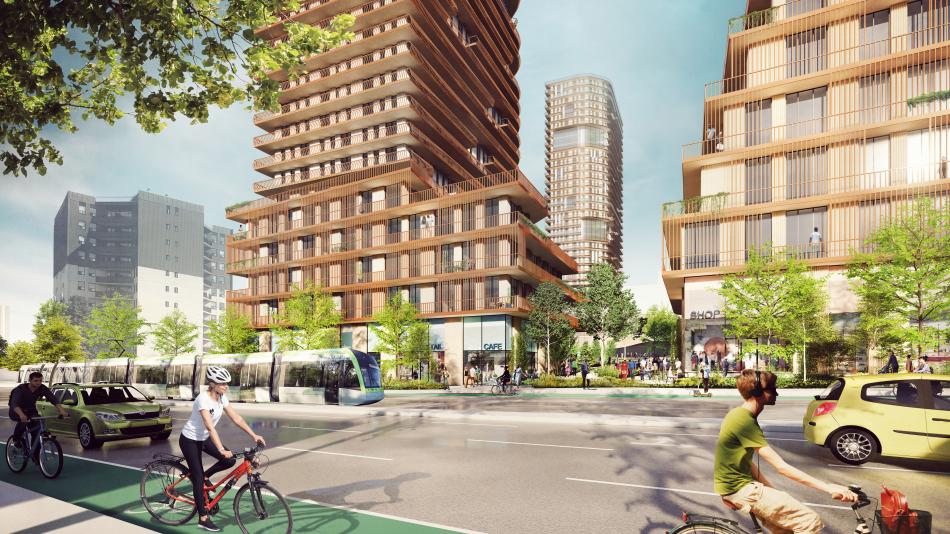 Retained by TAS , SvN is the lead planner and architect for the Connecting Cooksville development, located at the intersection of Hillcrest and Hurontario in Mississauga, at the centre of multiple rapid transit lines with regional connectivity – the Cooksville GO Station, the in-construction Hurontario LRT, and the planned Dundas Bus Rapid Transit. With a commitment to sustainable building practices, this new, mixed use Transit Oriented Development will deliver over 2000 homes, a full-service community centre and public library, set within an extensive and accessible public realm.Image via SvN
Retained by TAS , SvN is the lead planner and architect for the Connecting Cooksville development, located at the intersection of Hillcrest and Hurontario in Mississauga, at the centre of multiple rapid transit lines with regional connectivity – the Cooksville GO Station, the in-construction Hurontario LRT, and the planned Dundas Bus Rapid Transit. With a commitment to sustainable building practices, this new, mixed use Transit Oriented Development will deliver over 2000 homes, a full-service community centre and public library, set within an extensive and accessible public realm.Image via SvN
Thinking about the long-term vision of the community at the onset ensures that the development is not just responding to current needs but is also adaptable to future changes and growth. A well-designed TOC can act as a catalyst for further development in the area, creating a ripple effect that encourages additional investment and enhancement of neighboring areas.
We’ve seen this in action as SvN works to integrate early planning and design in our mandate for the Ontario Line project, to integrate transit-oriented development with the stations along the 15.5 km length. This reflects a comprehensive approach to development that recognizes the importance of early, collaborative planning in creating sustainable and thriving transit-oriented communities.
Q: What are the biggest challenges with designing and planning TOCs?
A: Like any process that has multiple stakeholders, developing and planning for TOCs requiresbalancing diverse interests and competing priorities of residents, businesses, transit authorities, and government entities. Even if all stakeholders come to a consensus, the project still needs to be financially feasible and provide a return on investment while serving public good. That, and achieving a consensus within the constraints of local regulations, codes, and laws is a complex process that involves priority setting and negotiation. Most importantly, projects must gain the support of the community, which includes addressing concerns around development impacts.
This challenge is pivotal because it influences and intersects with all other aspects of TOC development. Without addressing the diversity of interests and finding a common ground among stakeholders, it becomes difficult to move forward. This is why the early integration of stakeholder perspectives is essential to navigate this challenge successfully.
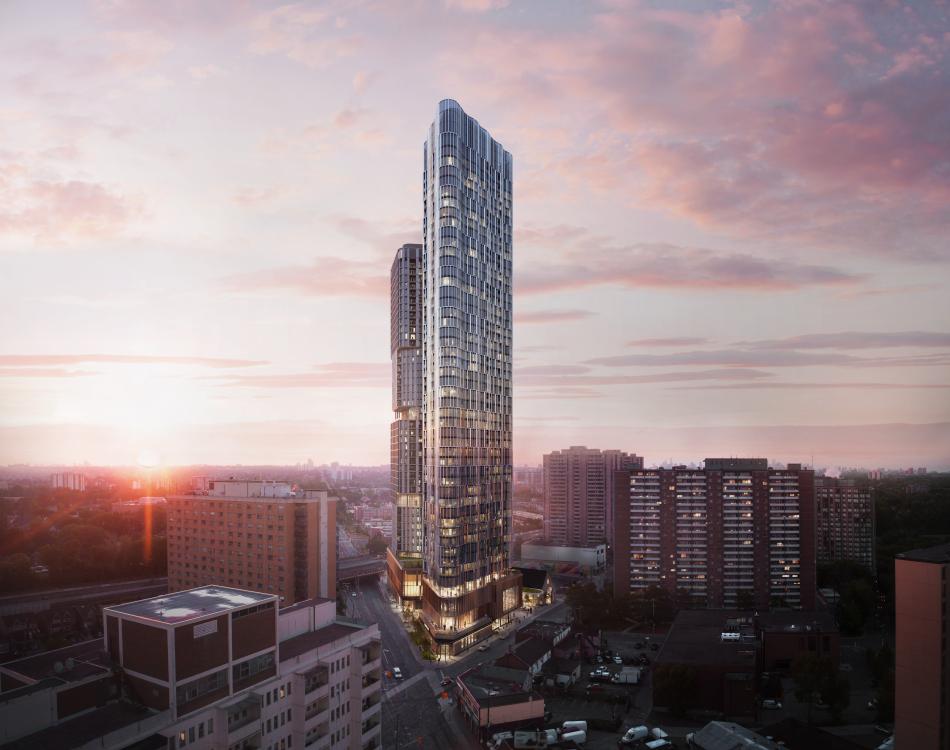 Partnering with Castlepoint Numa, Giannone Petricone Associates, and the Weston Park Baptist Church, SvN lead the redevelopment plans for Weston Park, a planned Transit Oriented Community at the intersection of Weston Road and Lawrence Avenue in Toronto. The mixed-use project will bring over 1000 new residential units, and approximately 39,000 sq. ft of community space and 14,500 square feet of retail to the area. Image via SvN
Partnering with Castlepoint Numa, Giannone Petricone Associates, and the Weston Park Baptist Church, SvN lead the redevelopment plans for Weston Park, a planned Transit Oriented Community at the intersection of Weston Road and Lawrence Avenue in Toronto. The mixed-use project will bring over 1000 new residential units, and approximately 39,000 sq. ft of community space and 14,500 square feet of retail to the area. Image via SvN
Q: What lessons can cities like Toronto learn from TOCs and Transit Oriented Development?
A: The most important thing we can learn is how to optimize the value of transit infrastructure. Transit infrastructure is one of the most expensive investments that a city can undertake. Once completed, the land held by a transit station is considered off limits from future intensification, which could mean that opportunities and value are being left on the table. For example, allowing development on top of – not just adjacent to - transit stations can bring a revenue stream to government who previously have not been able to capitalize on air rights. Traditionally, transit and residential development and public spaces have been thought of in silos. These things don't conflict with one another, so we should invest the time to bring them together to open the door for truly fulsome community building.
That's where we see the value of bringing in all shareholders and stakeholders from the initial planning stages of a project - to be sure that no opportunities are missed in development. Investing just six months at the onset of planning allows for the development of a known condition for all parties. Building on top of transit stations requires a criterion that matches the ambition of creating a complete community mitigates risks, including costs, timelines, resources.
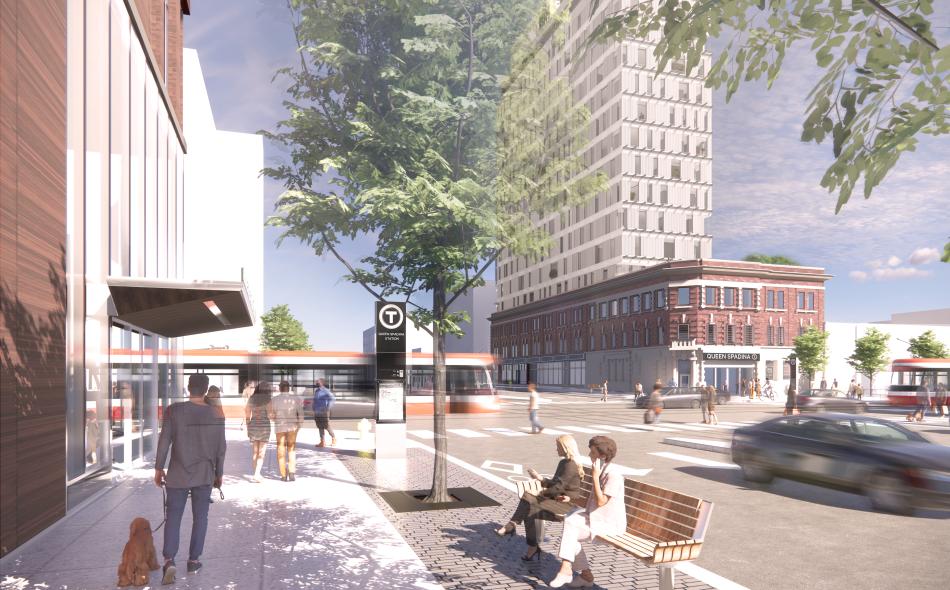 The Ontario Line’s Queen-Spadina Station is located at the north east and south west corners of the Queen-Spadina intersection in Toronto. Working with Metrolinx and Infrastructure Ontario, and as part of the Ontario Line Technical Advisor Team, SvN is the lead planner and architects for two sites to be developed through the Province of Ontario’s TOC program, introducing new landmark structures through a process of sensitive urban infill. These developments will reflect the rich cultural heritage value and character of Queen Street West and Spadina Avenue while contributing to the continuing growth of this area as a vibrant complete community.Image via SvN
The Ontario Line’s Queen-Spadina Station is located at the north east and south west corners of the Queen-Spadina intersection in Toronto. Working with Metrolinx and Infrastructure Ontario, and as part of the Ontario Line Technical Advisor Team, SvN is the lead planner and architects for two sites to be developed through the Province of Ontario’s TOC program, introducing new landmark structures through a process of sensitive urban infill. These developments will reflect the rich cultural heritage value and character of Queen Street West and Spadina Avenue while contributing to the continuing growth of this area as a vibrant complete community.Image via SvN
Q: Anything else?
A: Creating dynamic, sustainable, and inclusive urban environments that are centered around transit hubs is at the heart of SvN’s work. We focus on balancing technical, market, and community needs, suggesting a comprehensive and multi-disciplinary approach to creating TOCs for both public agencies as well as private development sites across the GTA. You can see this in action as we have already supported the securing of entitlements for eight development sites along the Ontario Line and continue that process for additional stations along the line.
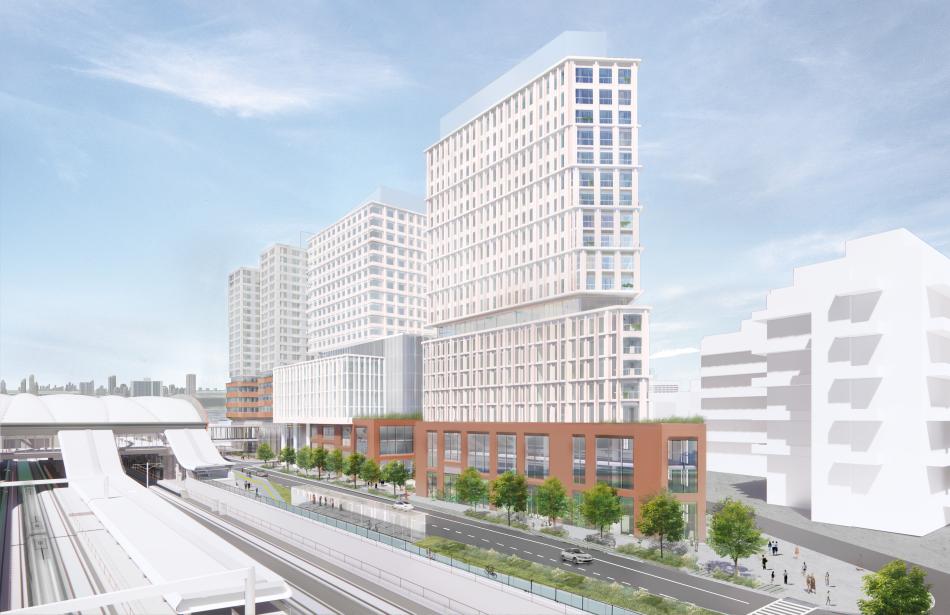 The Ontario Line’s Exhibition Station is located at the base of Atlantic Avenue in Liberty Village in Toronto. Working with Metrolinx and Infrastructure Ontario, and as part of the Ontario Line Technical Advisor Team, SvN is the lead planner and architect for two development sites within the Province of Ontario’s TOC program at 1 Atlantic Avenue, 1 Jefferson Avenue and 2-20 Atlantic Avenue. The proposed developments will anchor the south end of the Liberty Village Employment Area with mixed use TOCs re-oriented to Liberty New Street, a planned public street.Image via SvN
The Ontario Line’s Exhibition Station is located at the base of Atlantic Avenue in Liberty Village in Toronto. Working with Metrolinx and Infrastructure Ontario, and as part of the Ontario Line Technical Advisor Team, SvN is the lead planner and architect for two development sites within the Province of Ontario’s TOC program at 1 Atlantic Avenue, 1 Jefferson Avenue and 2-20 Atlantic Avenue. The proposed developments will anchor the south end of the Liberty Village Employment Area with mixed use TOCs re-oriented to Liberty New Street, a planned public street.Image via SvN
…
About Shonda Wang
Shonda Wang is a Principal at SvN with over thirty years of experience in community development and large-scale urban regeneration projects. She specializes in developing connections between the public realm, the built environment, and urban infrastructure — most notably, transportation infrastructure. Her work has won several awards for urban design, and she has served as a trusted strategic advisor to prominent clients in both the private and public sector. Since joining SvN in 2012, Shonda’s leadership has seen the firm expand its cross-disciplinary practice in Ontario, British Columbia, and Mexico.




